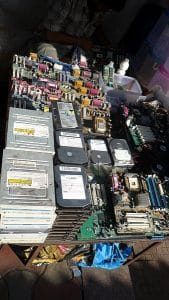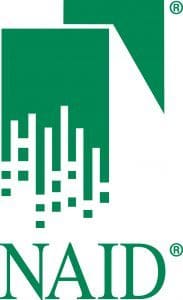Data security is a hot topic these days, and for good reason. In 2017 alone, 1,579 data breaches occurred in the United States with an average cost of $7.35 million per breach. According to the 2017 Data Breach Year-End Review released by the Identity Theft Resource Center (ITRC) and CyberScout, the 2017 breaches represent an unprecedented 44.7 percent increase over the record breaking number of breaches in 2016, and the number is only expected to grow. In fact, it is anticipated that the global cost of cybercrime will exceed $2 trillion by 2019, which is three times the 2015 estimate of $500 billion.
 The top five categories of organizations affected by data breaches include general business, medical/healthcare, banking/credit/financial, education, and government/military, in that order. These categories certainly make sense since they are the organizations that house the most sensitive, and therefore illicitly valuable, data. It should come as no surprise that of these organizations, government/military rounds out the bottom with less than five percent of total breaches. After all, the federal government understands the need for secrecy, and has set the bar for data security and privacy. Even commercial organizations are now trying to implement best practices originally dictated and instituted by government agencies, including the Department of Defense (DoD), the National Security Agency (NSA), Homeland Security, and the Department of Securities and Exchange.
The top five categories of organizations affected by data breaches include general business, medical/healthcare, banking/credit/financial, education, and government/military, in that order. These categories certainly make sense since they are the organizations that house the most sensitive, and therefore illicitly valuable, data. It should come as no surprise that of these organizations, government/military rounds out the bottom with less than five percent of total breaches. After all, the federal government understands the need for secrecy, and has set the bar for data security and privacy. Even commercial organizations are now trying to implement best practices originally dictated and instituted by government agencies, including the Department of Defense (DoD), the National Security Agency (NSA), Homeland Security, and the Department of Securities and Exchange.
Data breaches affect the privacy and security of individuals, businesses, and governments while costing the breached organization extensively. Costs include everything from covering credit monitoring for affected individuals to settling lawsuits to lost business and reputation. Cost per record of a U.S. data breach is an astounding $245, while the average number of exposed records is over 28,000. Add to that the fact that, according to Soha Systems Survey on Third Party Risk Management, 63 percent of all data breaches are linked to third parties such as vendors, contractors, or suppliers, while only two percent of IT professionals consider third party security a top concern. Clearly, the criticality of data security throughout its lifecycle, including end-of-life which is typically either controlled by a third party IT asset disposition company or ignored altogether, cannot be overstated. The grim reality is that businesses are fully responsible for the data that they collect and store, and a breach resulting from third-party culpability does not deflect liability.

It is easy to illustrate the severity of data insecurity resulting from third parties. Ghana, well known to be one of the top sources of cybercrime globally, is home to Agbogbloshie, a digital graveyard in the slums on the bank of the exceedingly polluted Korle Lagoon. This area, known as Sodom and Gomorrah by outsiders, is one of many computer and electronics landfills around the globe. Not only is this area an environmental disaster due to the antimony, arsenic, lead, mercury, and other toxic metals leaching into the water and soil from the electronic devices, it is also a hotbed of sensitive data waiting to be exposed. The discarded computers and electronic devices found in Agbogbloshie come from developed nations around the globe including the United States. Originally pitched to the locals as a means to help with the digital divide, these electronic “donations” actually contain less than 50 percent working computers with the rest being simply electronic trash. The residents have learned to salvage the devices or their parts to turn a small profit, but the real threat comes from the organized crime in the area that scours the drives for personal or sensitive information to use in scams or blackmail.

As part of an investigation into this digital dumping ground, journalism students from the University of Vancouver, British Columbia purchased seven hard drives at a cost of $35 from an Agbogbloshie e-waste dealer. What they found was shocking: credit card numbers, social security numbers, bank statements, as well as personal information and photos. They also retrieved a sensitive $22 million dollar U.S. defense contract from U.S. military contractor Northrop Grumman’s hard drive, which also contained sensitive contracts with NASA, the Transportation Security Administration (TSA), and Homeland Security. And all of this came from just seven hard drives.
In 2003, two Massachusetts Institute of Technology (MIT) graduate students published a study regarding their purchase of 158 hard drives from places such as eBay and small salvage companies. Of these, 49 contained sensitive information including PII, corporate financials, medical data, and over 5,000 credit card numbers. One of the students, Simson Garfinkel, is now the US Census Bureau’s Senior Computer Scientist for Confidentiality and Data Access and the Chair of the Bureau’s Disclosure Review Board. Prior to that, he was a computer scientist at the National Institute of Standards and Technology (NIST).
 In yet another 2003 study, Tom Spring from PC World Magazine acquired ten used hard drives in the Boston, MA area from thrift stores and salvage yards. Nine of these ten drives contained sensitive data including social security numbers, credit card numbers, and banking statements, as well as tax, medical, and legal records. Using the information found on the drives, Spring contacted the original owners of the drives, some of whom had contracted electronics disposal or recycling companies to erase their hard drives.
In yet another 2003 study, Tom Spring from PC World Magazine acquired ten used hard drives in the Boston, MA area from thrift stores and salvage yards. Nine of these ten drives contained sensitive data including social security numbers, credit card numbers, and banking statements, as well as tax, medical, and legal records. Using the information found on the drives, Spring contacted the original owners of the drives, some of whom had contracted electronics disposal or recycling companies to erase their hard drives.
In 2006, Idaho Power Company learned that 84 of the 230 hard drives they had contracted salvage vendor Grant Korth to sanitize and recycle had actually been sold to third parties on eBay. These drives contained sensitive information including proprietary company information, confidential correspondence, and employee data including social security numbers.
In 2009, Kessler International, a New York based computer forensic firm, purchased 100 drives from eBay over a period of six months. 40 of these drives were found to contain sensitive, confidential, and personally identifiable information as well as corporate financials, personal photos and emails, and even one company’s secret French fry recipe.
 In 2014, the National Association for Information Destruction ANZ (NAID-ANZ) published a study regarding their purchase of 52 used hard drives from eBay and other third parties. The recovered drives came from law firms, accountants, medical facilities, educational institutions, and numerous individuals. Data recovered included medical records, social security numbers, tax and financial information, sensitive court case documents, personal photos and videos, bank statements, confidential client information, disability insurance applications including highly sensitive personal financial and medical information, profit and loss statements, employee HR files, company invoices, and spreadsheets including name, address, phone number, salary, DOB, and occupation. Of the drives with recoverable information, over 90 percent of them had deleted or formatted partitions, a clear indicator that the owner had made an attempt to sanitize the data prior to disposal.
In 2014, the National Association for Information Destruction ANZ (NAID-ANZ) published a study regarding their purchase of 52 used hard drives from eBay and other third parties. The recovered drives came from law firms, accountants, medical facilities, educational institutions, and numerous individuals. Data recovered included medical records, social security numbers, tax and financial information, sensitive court case documents, personal photos and videos, bank statements, confidential client information, disability insurance applications including highly sensitive personal financial and medical information, profit and loss statements, employee HR files, company invoices, and spreadsheets including name, address, phone number, salary, DOB, and occupation. Of the drives with recoverable information, over 90 percent of them had deleted or formatted partitions, a clear indicator that the owner had made an attempt to sanitize the data prior to disposal.
We could go on and on.
When disposing of end-of-life data, many companies turn to data disposal or recycling vendors and assume that their drives — and the data they contain — are being handled responsibly and safely. The reality is far different. While there are certainly many reputable data sanitization companies, it is just too risky to entrust sensitive information to any third party, simply because of the unknown. In addition to sloppy or greedy third party IT asset disposition companies, there are a growing number of sham recyclers in operation – companies that offer to pick up and recycle PCs for free, then actually sell them to cyber criminals specifically so they can mine the data they contain for illicit activity.

The only truly secure method of IT asset disposition is drive destruction. While it is tempting to make a few dollars per drive by sending to a recycler or attempting to wipe and resell, the potential cost of a data breach far outweighs any financial gain from reselling. The National Security Agency has long known this truth and requires rotational platter based hard drives to be both degaussed (erased) AND physically destroyed prior to disposal. Not only does drive destruction through crushing, shredding, or disintegration ensure data privacy and security, it also is environmentally responsible. Shredded hard drive scraps are more easily sorted for metals recycling, leaving a smaller quantity of true waste and less likely to end up in Agbogbloshie.

